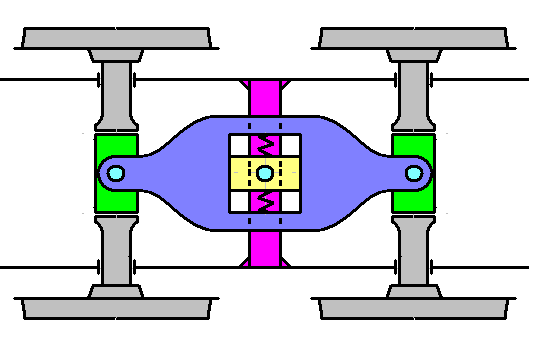Beugniot Lever on:
[Wikipedia]
[Google]
[Amazon]
 The Beugniot lever (''Beugniot-Hebel'') is a mechanical device used on a number of
The Beugniot lever (''Beugniot-Hebel'') is a mechanical device used on a number of
Explanation of the Beugniot lever (bottom of linked paged)
{{Locomotive running gear Steam locomotive technologies Locomotive parts
 The Beugniot lever (''Beugniot-Hebel'') is a mechanical device used on a number of
The Beugniot lever (''Beugniot-Hebel'') is a mechanical device used on a number of locomotive
A locomotive is a rail transport, rail vehicle that provides the motive power for a train. Traditionally, locomotives pulled trains from the front. However, Push–pull train, push–pull operation has become common, and in the pursuit for ...
s to improve curve running. It was named after its inventor Édouard Beugniot.
Overview
Around 1860, when Beugniot was the chief engineer at the firm of André Koechlin & Cie. inMulhouse
Mulhouse (; ; Alsatian language, Alsatian: ''Mìlhüsa'' ; , meaning "Mill (grinding), mill house") is a France, French city of the European Collectivity of Alsace (Haut-Rhin department, in the Grand Est region of France). It is near the Fran ...
, he developed a system whereby wheelsets are housed in pairs in the locomotive frame
A locomotive frame is the structure that forms the backbone of the railway locomotive, giving it strength and supporting the superstructure elements such as a cab, boiler or bodywork. The vast majority of locomotives have had a frame structure ...
, with side-play, and connected by a lever. These levers are fixed to the frame in the centre and thus enable the sideways movement of the connected axles in opposite directions. In this way, instead of being fixed in the frame, the axles are able to move sideways rather like a bogie
A bogie ( ) (or truck in North American English) comprises two or more Wheelset (rail transport), wheelsets (two Railroad wheel, wheels on an axle), in a frame, attached under a vehicle by a pivot. Bogies take various forms in various modes ...
, but clearly nowhere near as much. On locomotives with a side rod drive, the axle side-play is balanced using longer coupling pins (''Kuppelzapfen'') on which the coupling rods
A coupling is a device used to connect two shafts together at their ends for the purpose of transmitting power. The primary purpose of couplings is to join two pieces of rotating equipment while permitting some degree of misalignment or end mo ...
are also able to move sideways.
Operation
On running round a bend, the first axle is pushed sideways by the curve of the rails and so moves the second axle parallel to it in the opposite direction, until the wheel flanges of both axles align with the rails. This distributes the guide forces between the two axles which reduces wear and tear on the wheel flanges. By enabling this transverse movement of the wheelsets, locomotives with rigid frames do not have to use the thinner wheel flanges etc. normally needed to facilitate smooth running through points, bends and tightly curved sections of track. The 'guide length' of the locomotive is formed by the distance between the two fixed Beugniot lever pivot points.Examples
In Germany, Beugniot levers were used mainly in the middle of the 20th century. The best known examples of locomotives that use this type of lever are theMaK
Mak may refer to:
People
*Mak Dizdar (1917 - 1971), Bosnian poet
*Muhammad Arshad Khan, Pakistani painter popularly known as "MAK"
*Alan Mak (director) (born 1968), Hong Kong film director
* Alan Mak (politician) (born 1984), British Member of Pa ...
side-rod drive locomotives, the Class 105 and 106 engines in East Germany
East Germany, officially known as the German Democratic Republic (GDR), was a country in Central Europe from Foundation of East Germany, its formation on 7 October 1949 until German reunification, its reunification with West Germany (FRG) on ...
as well as steam locomotives like the DB Class 82.
Sources
Bedienungs- und Wartungsanleitungen derMaK
Mak may refer to:
People
*Mak Dizdar (1917 - 1971), Bosnian poet
*Muhammad Arshad Khan, Pakistani painter popularly known as "MAK"
*Alan Mak (director) (born 1968), Hong Kong film director
* Alan Mak (politician) (born 1984), British Member of Pa ...
-Baureihen 600 D, 650 D und 1200 D
External links
Explanation of the Beugniot lever (bottom of linked paged)
{{Locomotive running gear Steam locomotive technologies Locomotive parts